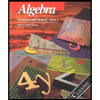
Mathematical Methods in the Physical Sciences
3rd Edition
ISBN: 9780471198260
Author: Mary L. Boas
Publisher: Wiley, John & Sons, Incorporated
expand_more
expand_more
format_list_bulleted
Textbook Question
Chapter 12.5, Problem 10P
Express each of the following polynomials as linear combinations of Legendre polynomials. Hint: Start with the highest power of
Expert Solution & Answer
Want to see the full answer?
Check out a sample textbook solution
Chapter 12 Solutions
Mathematical Methods in the Physical Sciences
Ch. 12.1 - Solve the following differential equations by...Ch. 12.1 - Solve the following differential equations by...Ch. 12.1 - Solve the following differential equations by...Ch. 12.1 - Solve the following differential equations by...Ch. 12.1 - Solve the following differential equations by...Ch. 12.1 - Solve the following differential equations by...Ch. 12.1 - Solve the following differential equations by...Ch. 12.1 - Solve the following differential equations by...Ch. 12.1 - Solve the following differential equations by...Ch. 12.1 - Solve the following differential equations by...
Ch. 12.2 - Using (2.6) and (2.7) and the requirement that...Ch. 12.2 - Show that Pl(1)=(1)l. Hint: When is Pl(x) an even...Ch. 12.2 - Computer plot graphs of Pl(x) for l=0,1,2,3,4, and...Ch. 12.2 - Use the method of reduction of order [Chapter 8,...Ch. 12.3 - By Leibniz' rule, write the formula for...Ch. 12.3 - Use Problem 1 to find the following derivatives....Ch. 12.3 - Use Problem 1 to find the following derivatives....Ch. 12.3 - Use Problem 1 to find the following derivatives....Ch. 12.3 - Use Problem 1 to find the following derivatives....Ch. 12.3 - Verify Problem 1. Hints: One method is to use...Ch. 12.4 - Verify equations (4.4) and (4.5). (4.4)...Ch. 12.4 - Show that Pl(1)=1, with P1(x) given by (4.1), in...Ch. 12.4 - Find P0(x),P1(x),P2(x),P3(x), and P4(x) from...Ch. 12.4 - Show that 11xmPl(x)dx=0 if ml. Hint: Use...Ch. 12.5 - Find P3(x) by getting one more term in the...Ch. 12.5 - Verify (5.5) using (5.1). (5.1)...Ch. 12.5 - Use the recursion relation (5.8a) and the values...Ch. 12.5 - Show from (5.1) that (xh)x=hh. Substitute the...Ch. 12.5 - Differentiate the recursion relation (5.8a) and...Ch. 12.5 - From (5.8b) and (5.8c), obtain (5.8d) and (5.8f)....Ch. 12.5 - Write (5.8c) with l replaced by l+1 and use it to...Ch. 12.5 - Express each of the following polynomials as...Ch. 12.5 - Express each of the following polynomials as...Ch. 12.5 - Express each of the following polynomials as...Ch. 12.5 - Express each of the following polynomials as...Ch. 12.5 - Express each of the following polynomials as...Ch. 12.5 - Express each of the following polynomials as...Ch. 12.5 - Show that any polynomial of degree n can be...Ch. 12.5 - Expand the potential V=K/d in (5.11) in the...Ch. 12.6 - Show that if abA*(x)B(x)dx=0 [see (6.3)], then...Ch. 12.6 - Show that the functions einx/l,n=0,1,2,, are a set...Ch. 12.6 - Show that the functions x2 and sinx are orthogonal...Ch. 12.6 - Show that the functions f(x) and g(x) are...Ch. 12.6 - Evaluate 11P0(x)P2(x)dx to show that these...Ch. 12.6 - Show in two ways that Pl(x) and Pl(x) are...Ch. 12.6 - Show that the set of functions sinnx is not a...Ch. 12.6 - Show that the functions cosn+12x,n=0,1,2,, are...Ch. 12.6 - Show in two ways that 11P2n+1(x)dx=0.Ch. 12.7 - By a method similar to that we used to show that...Ch. 12.7 - Following the method in (7.2) to (7.5), show that...Ch. 12.7 - Use Problem 4.4 to show that 11Pm(x)Pl(x)dx=0 if...Ch. 12.7 - Use equation (7.6) to show that 11Pl(x)Pl1(x)dx=0....Ch. 12.7 - Show that 11Pl(x)dx=0,l0. Hint: Consider...Ch. 12.7 - Show that P1(x) is orthogonal to Pl(x)2 on (1,1)....Ch. 12.8 - Find the norm of each of the following functions...Ch. 12.8 - Find the norm of each of the following functions...Ch. 12.8 - Find the norm of each of the following functions...Ch. 12.8 - Find the norm of each of the following functions...Ch. 12.8 - Find the norm of each of the following functions...Ch. 12.8 - Give another proof of (8.1) as follows. Multiply...Ch. 12.8 - Using (8.1), write the first four normalized...Ch. 12.9 - Expand the following functions in Legendre series....Ch. 12.9 - Expand the following functions in Legendre series....Ch. 12.9 - Expand the following functions in Legendre series....Ch. 12.9 - Expand the following functions in Legendre series....Ch. 12.9 - Expand the following functions in Legendre series....Ch. 12.9 - Expand the following functions in Legendre series....Ch. 12.9 - Expand the following functions in Legendre series....Ch. 12.9 - Expand the following functions in Legendre series....Ch. 12.9 - Expand the following functions in Legendre series....Ch. 12.9 - Expand each of the following polynomials in a...Ch. 12.9 - Expand each of the following polynomials in a...Ch. 12.9 - Expand each of the following polynomials in a...Ch. 12.9 - Find the best (in the least squares sense)...Ch. 12.9 - Find the best (in the least squares sense)...Ch. 12.9 - Find the best (in the least squares sense)...Ch. 12.9 - Prove the least squares approximation property of...Ch. 12.10 - Verify equations (10.3) and (10.4). (10.4)...Ch. 12.10 - The equation for the associated Legendre functions...Ch. 12.10 - Show that the functions Plm(x) for each m are a...Ch. 12.10 - Substitute the Pl(x) you found in Problems 4.3 or...Ch. 12.10 - Substitute the Pl(x) you found in Problems 4.3 or...Ch. 12.10 - Substitute the P1(x) you found in Problems 4.3 or...Ch. 12.10 - Show that...Ch. 12.10 - Write (10.7) with m replaced by m; then use...Ch. 12.10 - Use Problem 7 to show that...Ch. 12.10 - Derive (10.8) as follows: Multiply together the...Ch. 12.11 - Finish the solution of equation (11.2) when s=2....Ch. 12.11 - Solve the following differential equations by the...Ch. 12.11 - Solve the following differential equations by the...Ch. 12.11 - Solve the following differential equations by the...Ch. 12.11 - Solve the following differential equations by the...Ch. 12.11 - Solve the following differential equations by the...Ch. 12.11 - Solve the following differential equations by the...Ch. 12.11 - Solve the following differential equations by the...Ch. 12.11 - Solve the following differential equations by the...Ch. 12.11 - Solve the following differential equations by the...Ch. 12.11 - Solve the following differential equations by the...Ch. 12.11 - Solve the following differential equations by the...Ch. 12.11 - Consider each of the following problems as...Ch. 12.11 - Solve y=y by the Frobenius method. You should find...Ch. 12.12 - Show by the ratio test that the infinite series...Ch. 12.12 - Use (12.9) to show that: J2(x)=(2/x)J1(x)J0(x)Ch. 12.12 - Use (12.9) to show that: J1(x)+J3(x)=(4/x)J2(x)Ch. 12.12 - Use (12.9) to show that: (d/dx)J0(x)=J1(x)Ch. 12.12 - Use (12.9) to show that: (d/dx)xJ1(x)=xJ0(x)Ch. 12.12 - Use (12.9) to show that: J0(x)J2(x)=2(d/dx)J1(x)Ch. 12.12 - Use (12.9) to show that: limx0J1(x)/x=12Ch. 12.12 - Use (12.9) to show that: limx0x3/2J3/2(x)=312/...Ch. 12.12 - Use (12.9) to show that: x/2J1/2(x)=sinxCh. 12.13 - Using equations (12.9) and (13.1), write out the...Ch. 12.13 - Show that, in general for integral...Ch. 12.13 - Use equations (12.9) and (13.1) to show that:...Ch. 12.13 - Use equations (12.9) and (13.1) to show that:...Ch. 12.13 - Use equations (12.9) and (13.1) to show that:...Ch. 12.13 - Use equations (12.9) and (13.1) to show that: Show...Ch. 12.14 - By computer, plot graphs of Jp(x) for p=0,1,2,3,...Ch. 12.14 - From the graphs in Problem 1, read approximate...Ch. 12.14 - By computer, plot N0(x) for x from 0 to 15, and...Ch. 12.14 - From the graphs in Problem 3, read approximate...Ch. 12.14 - By computer, plot xJ1/2(x) for x from 0 to 4. Do...Ch. 12.14 - By computer, find 30 zeros of J0 and note that the...Ch. 12.15 - Prove equation (15.2) by a method similar to the...Ch. 12.15 - Solve equations (15.1) and (15.2) for Jp+1(x) and...Ch. 12.15 - Carry out the differentiation in equations (15.1)...Ch. 12.15 - Use equations (15.1) to (15.5) to do Problems 12.2...Ch. 12.15 - Using equations (15.4) and (15.5), show that...Ch. 12.15 - As in Problem 5, show that Jp1(x)=Jp+1(x) at every...Ch. 12.15 - (a) Using (15.2), show that 0J1(x)dx=J0(x)0=1. (b)...Ch. 12.15 - From equation (15.4), show that...Ch. 12.15 - Use L23 and L32 of the Laplace Transform Table...Ch. 12.16 - Find the solutions of the following differential...Ch. 12.16 - Find the solutions of the following differential...Ch. 12.16 - Find the solutions of the following differential...Ch. 12.16 - Find the solutions of the following differential...Ch. 12.16 - Find the solutions of the following differential...Ch. 12.16 - Find the solutions of the following differential...Ch. 12.16 - Find the solutions of the following differential...Ch. 12.16 - Find the solutions of the following differential...Ch. 12.16 - Find the solutions of the following differential...Ch. 12.16 - Find the solutions of the following differential...Ch. 12.16 - Find the solutions of the following differential...Ch. 12.16 - Find the solutions of the following differential...Ch. 12.16 - Verify by direct substitution that the text...Ch. 12.16 - Use (16.5) to write the solutions of the following...Ch. 12.16 - Use ( 16.5 ) to write the solutions of the...Ch. 12.16 - Use (16.5) to write the solutions of the following...Ch. 12.16 - Use (16.5) to write the solutions of the following...Ch. 12.17 - Write the solutions of Problem 16.1 as spherical...Ch. 12.17 - From Problem (12.9) J1/2(x)=2/xsinx. Use (15.2) to...Ch. 12.17 - From Problems 13.3 and 13.5, Y1/2(x)=2/x cos x. As...Ch. 12.17 - Using (17.3) and the results stated in Problems 2...Ch. 12.17 - Show from (17.4) that hn(1)(x)=ixn1xddxneixx.Ch. 12.17 - Using (16.1) and (17.4) show that the spherical...Ch. 12.17 - (a) Solve the differential equation xy=y using...Ch. 12.17 - Using (16.1) and (16.2), verify that (a) the...Ch. 12.17 - Using (17.3) and (15.1) to (15.5), find the...Ch. 12.17 - Computer plot (a) I0(x),I1(x),I2(x), from x=0 to...Ch. 12.17 - From (17.4), show that hn(1)(ix)=ex/x.Ch. 12.17 - Use the Section 15 recursion relations and (17.4)...Ch. 12.17 - Use the Section 15 recursion relations and (17.4)...Ch. 12.17 - Use the Section 15 recursion relations and (17.4)...Ch. 12.17 - Use the Section 15 recursion relations and (17.4)...Ch. 12.17 - Use the Section 15 recursion relations and (17.4)...Ch. 12.18 - Verify equation (18.3) Hint: From equation (18.2),...Ch. 12.18 - Solve equation (18.3) to get equation (18.4).Ch. 12.18 - Prove Jp(x)Jp(x)Jp(x)Jp(x)=2xsinp as follows:...Ch. 12.18 - Using equation (13.3) and Problem 3, show that...Ch. 12.18 - Use the recursion relations of Section 15 (for N s...Ch. 12.18 - For the initial conditions =0,=0, show that the...Ch. 12.18 - Prob. 7PCh. 12.18 - Find =ddt=ddududldldt either from equations...Ch. 12.18 - Consider the shortening pendulum problem. Follow...Ch. 12.18 - The differential equation for transverse...Ch. 12.18 - A straight wire clamped vertically at its lower...Ch. 12.19 - Prove equation (19.10) in the following way. First...Ch. 12.19 - Given that J3/2(x)=2xsinxxcosx, use (19.10) to...Ch. 12.19 - Use (17.4) and (19.10) to write the orthogonality...Ch. 12.19 - Define Jp(z) for complex z by the power series...Ch. 12.19 - We obtained (19.10) for Jp(x),p0. It is, however,...Ch. 12.19 - By Problem 5,01xN1/2(x)N1/2(x)dx=0 if and are...Ch. 12.20 - Use the table above to evaluate the following...Ch. 12.20 - Use the table above to evaluate the following...Ch. 12.20 - Use the table above to evaluate the following...Ch. 12.20 - Use the table above to evaluate the following...Ch. 12.20 - Use the table above to evaluate the following...Ch. 12.20 - Use the table above to evaluate the following...Ch. 12.20 - Use the table above and the definitions in Section...Ch. 12.20 - Use the table above and the definitions in Section...Ch. 12.20 - Use the table above and the definitions in Section...Ch. 12.20 - Use the table above and the definitions in Section...Ch. 12.20 - To study the approximations in the table, computer...Ch. 12.20 - To study the approximations in the table, computer...Ch. 12.20 - To study the approximations in the table, computer...Ch. 12.20 - To study the approximations in the table, computer...Ch. 12.20 - To study the approximations in the table, computer...Ch. 12.20 - To study the approximations in the table, computer...Ch. 12.20 - To study the approximations in the table, computer...Ch. 12.20 - To study the approximations in the table, computer...Ch. 12.20 - Computer plot on the same axes several Ip(x)...Ch. 12.20 - As in Problem 19, study the Kp(x) functions. It is...Ch. 12.21 - For Problems 1 to 4, find one (simple) solution of...Ch. 12.21 - For Problems 1 to 4, find one (simple) solution of...Ch. 12.21 - For Problems 1 to 4, find one (simple) solution of...Ch. 12.21 - For Problems 1 to 4, find one (simple) solution of...Ch. 12.21 - Solve the differential equations in Problems 5 to...Ch. 12.21 - Solve the differential equations in Problems 5 to...Ch. 12.21 - Solve the differential equations in Problems 5 to...Ch. 12.21 - Solve the differential equations in Problems 5 to...Ch. 12.21 - Solve the differential equations in Problems 5 to...Ch. 12.21 - Solve the differential equations in Problems 5 to...Ch. 12.21 - For the differential equation in Problem 2, verify...Ch. 12.21 - Verify that the differential equation x4y+y=0 is...Ch. 12.21 - Verify that the the differential equation in...Ch. 12.22 - Verify equations (22.2), (22.3), (22.4), and...Ch. 12.22 - Solve (22.9) to get (22.10). If needed, see...Ch. 12.22 - Show that ex2/2Dex2/2f(x)=(Dx)f(x). Now set...Ch. 12.22 - Using (22.12) find the Hermite polynomials given...Ch. 12.22 - By power series, solve the Hermite differential...Ch. 12.22 - Substitute yn=ex2/2Hn(x) into (22.1) to show that...Ch. 12.22 - Prove that the functions Hn(x) are orthogonal on...Ch. 12.22 - In the generating function (22.16), expand the...Ch. 12.22 - Use the generating function to prove the recursion...Ch. 12.22 - Evaluate the normalization integral in (22.15)....Ch. 12.22 - Show that we have solved the following eigenvalue...Ch. 12.22 - Using Leibniz' rule (Section 3), carry out the...Ch. 12.22 - Using (22.19) verify (22.20) and also find L3(x)...Ch. 12.22 - Show that y=Ln(x) given in ( 22.18 ) satisfies (...Ch. 12.22 - Solve the Laguerre differential equation...Ch. 12.22 - Prove that the functions Ln(x) are orthogonal on...Ch. 12.22 - In (22.23), write the series for the exponential...Ch. 12.22 - Verify the recursion relations (22,24) as follows:...Ch. 12.22 - Evaluate the normalization integral in (22.22)....Ch. 12.22 - Using (22.25),(22.20), and Problem 13, find Lnk(x)...Ch. 12.22 - Verify that the polynomials Lnk(x) in ( 22.25 )...Ch. 12.22 - Verify that the polynomials given by (22.27) are...Ch. 12.22 - Verify the recursion relation relations (22.28) as...Ch. 12.22 - Show that the functions Lnk(x) are orthogonal on...Ch. 12.22 - Evaluate the normalization integrals ( 22.29 ) and...Ch. 12.22 - Solve the following eigenvalue problem (see end of...Ch. 12.22 - The functions which are of interest in the theory...Ch. 12.22 - Repeat Problem 27 for l=0,n=1,2,3.Ch. 12.22 - Show that Rp=pxD and Lp=px+D where D=d/dx, are...Ch. 12.22 - Find raising and lowering operators (see Problem...Ch. 12.23 - Use the generating function (5.1) to find the...Ch. 12.23 - Use the generating function to show that...Ch. 12.23 - Use (5.78e) to show that...Ch. 12.23 - Obtain the binomial coefficient result in Problem...Ch. 12.23 - Show that 0n(2l+1)Pl(x)=Pn(x)+Pn+1(x). Hint: Use...Ch. 12.23 - Using (10.6), (5.8), and Problem 2, evaluate...Ch. 12.23 - Show that, for l0,0bP(x)dx=0 if a and b are any...Ch. 12.23 - Show that (2l+1)x21Pl(x)=l(l+1)Pl+1(x)Pl1(x)....Ch. 12.23 - Evaluate 11xPi(x)Pn(x)dx,nl. Hint: Write (5.8a)...Ch. 12.23 - Use the recursion relations of Section 15 (and, as...Ch. 12.23 - Use the recursion relations of Section 15 (and, as...Ch. 12.23 - Use the recursion relations of Section 15 (and, as...Ch. 12.23 - Wre the recursion relations of Section 15 (and, as...Ch. 12.23 - Use the recursion relations of Section 15 (and, as...Ch. 12.23 - Use the result of Problem 18.4 and equations...Ch. 12.23 - Use (15.2) repeatedly to show that...Ch. 12.23 - Let be the first positive zero of J1(x) and let n...Ch. 12.23 - (a) Make the change of variables z=ex in the...Ch. 12.23 - (a) The generating function for Bessel functions...Ch. 12.23 - In the generating function equation of Problem 19,...Ch. 12.23 - In the generating function equation, Problem 19,...Ch. 12.23 - In the cos(xsin) series of Problem 20, let =0, and...Ch. 12.23 - Solve by power series 1x2yxy+n2y=0. The polynomial...Ch. 12.23 - (a) The following differential equation is often...Ch. 12.23 - In Problem 22.26, replace x by x/n in the y...Ch. 12.23 - Verify Bauers formula eixw=0(2l+1)iiji(x)Pl(w) as...Ch. 12.23 - Show that R=lx1x2D and L=lx+1x2D, where D=d/dx,...Ch. 12.23 - Show that the functions J0(t) and J0(t) are...Ch. 12.23 - Show that the Fourier cosine transform (Chapter 7,...Ch. 12.23 - Use the results of Chapter 7, Problems 12.18 and...
Additional Math Textbook Solutions
Find more solutions based on key concepts
In Exercises 9-26, use the counting principle to determine the answer to part (a). Assume that each event is eq...
A Survey of Mathematics with Applications (10th Edition) - Standalone book
In Exercises 11-20, express each decimal as a percent.
11. 0.59
Thinking Mathematically (7th Edition)
13-22: And Probabilities. Determine whether the events described in each exercise are independent or dependent....
Using & Understanding Mathematics: A Quantitative Reasoning Approach (7th Edition)
A pool is surrounded by a brick walkway as shown in the diagram. The pool is 3 feet deep and the walkway is 4 f...
Mathematics All Around (6th Edition)
The validity of the statement “if two balls are drawn with replacement, then PB1|B2=PB2|B1 ”.
Finite Mathematics for Business, Economics, Life Sciences and Social Sciences
Assessment 1-1A In a big red box, there are 7 smaller blue boxes. In each of the blue boxes, there are 7 black ...
A Problem Solving Approach to Mathematics for Elementary School Teachers (12th Edition)
Knowledge Booster
Learn more about
Need a deep-dive on the concept behind this application? Look no further. Learn more about this topic, subject and related others by exploring similar questions and additional content below.Similar questions
- Find the quartic (fourth-degree) polynomial function f with real coefficients that has 1,2and2i, as zeros, and f(1)=10.arrow_forwardLabel each of the following statements as either true or false. We say that cF is a solution to the polynomial equation f(x)=0 if and only if f(c)=0inF.arrow_forwardWrite each of the following polynomials as a products of its leading coefficient and a finite number of monic irreducible polynomials over 5. State their zeros and the multiplicity of each zero. 2x3+1 3x3+2x2+x+2 3x3+x2+2x+4 2x3+4x2+3x+1 2x4+x3+3x+2 3x4+3x3+x+3 x4+x3+x2+2x+3 x4+x3+2x2+3x+2 x4+2x3+3x+4 x5+x4+3x3+2x2+4xarrow_forward
arrow_back_ios
arrow_forward_ios
Recommended textbooks for you
 Elements Of Modern AlgebraAlgebraISBN:9781285463230Author:Gilbert, Linda, JimmiePublisher:Cengage Learning,Algebra & Trigonometry with Analytic GeometryAlgebraISBN:9781133382119Author:SwokowskiPublisher:Cengage
Elements Of Modern AlgebraAlgebraISBN:9781285463230Author:Gilbert, Linda, JimmiePublisher:Cengage Learning,Algebra & Trigonometry with Analytic GeometryAlgebraISBN:9781133382119Author:SwokowskiPublisher:Cengage Linear Algebra: A Modern IntroductionAlgebraISBN:9781285463247Author:David PoolePublisher:Cengage Learning
Linear Algebra: A Modern IntroductionAlgebraISBN:9781285463247Author:David PoolePublisher:Cengage Learning
 Algebra: Structure And Method, Book 1AlgebraISBN:9780395977224Author:Richard G. Brown, Mary P. Dolciani, Robert H. Sorgenfrey, William L. ColePublisher:McDougal Littell
Algebra: Structure And Method, Book 1AlgebraISBN:9780395977224Author:Richard G. Brown, Mary P. Dolciani, Robert H. Sorgenfrey, William L. ColePublisher:McDougal Littell

Elements Of Modern Algebra
Algebra
ISBN:9781285463230
Author:Gilbert, Linda, Jimmie
Publisher:Cengage Learning,

Algebra & Trigonometry with Analytic Geometry
Algebra
ISBN:9781133382119
Author:Swokowski
Publisher:Cengage

Linear Algebra: A Modern Introduction
Algebra
ISBN:9781285463247
Author:David Poole
Publisher:Cengage Learning


Algebra: Structure And Method, Book 1
Algebra
ISBN:9780395977224
Author:Richard G. Brown, Mary P. Dolciani, Robert H. Sorgenfrey, William L. Cole
Publisher:McDougal Littell
Interpolation | Lecture 43 | Numerical Methods for Engineers; Author: Jffrey Chasnov;https://www.youtube.com/watch?v=RpxoN9-i7Jc;License: Standard YouTube License, CC-BY